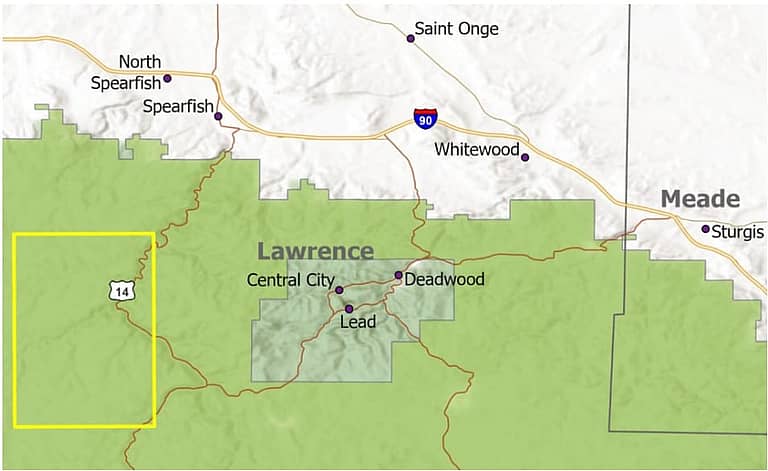Forest Service disregards hundreds of objections to Golden Crest Exploration Drilling
A proposed drilling project in the Black Hills, which would include placing two dozen drilling pads upstream of the Spearfish Canyon, looks to be moving forward despite hundreds of objections. The popular recreation area is immediately west of Spearfish Canyon.
Lilias Jarding from the Black Hills Clean Water Alliance said that the U.S. Forest Service is moving directly to a decision after releasing their draft decision to let the Gold Crest drilling project commence because they found “no significant impact.” Jarding said that the Black Hills Clean Water Alliance had put time and effort into the process only to see the Forest Service rebuff their efforts. She said it was insulting “Basically, the Forest Service said that they have done all they have to do.”
Jarding said the Forest Service is not taking the public input seriously. She said that the Forest Service had determined that 122 of the nearly 400 public comments objecting to the project are eligible for review but never held an objection resolution meeting, which is the typical process. “What they didn’t do was have a meeting between the objectors and the Forest Service. They don’t have to do it but they have done it in the past, for instance Jenny Gulch.” But not this time. “The objectors found out that their objections would not be heard in a separate meeting and instead the Forest Service is going ahead with its final decision.”
The Alliance in a news release said they object to the lack of public input. “It’s unclear whether the Forest Service really evaluated a number of serious issues raised by the public.” Those issues included questions about Tribal consultation, the impacts of other activities in the area, hazardous materials, potential water contamination and impacts to outdoor recreation.
Jarding said that Solitario, the company proposing the project, has this claim in Spearfish Canyon where they want to drill. They also have a large area of claims southwest of Cheyenne Crossing, which is part of another claim called the Ponderosa Project. But Solitario is not the only company with large claims. “There’s a lot of places where drillers have claims. There are 293-thousand acres in the Black Hills that are under active mining claims and with Forest Service permission or state permission or both, those could become areas subject to exploratory drilling.
Jarding said that people in the Black Hills and West River should know that the entire area will be impacted by a renewal of additional large scale mining. “Whether they are recreationists, fishing in Pactola or hiking in Custer, mining will impact that activity and in turn will impact the economy. Outdoor tourists don’t’ want to see open-pit mines.”
Mining is the original industry in South Dakota. The 1872 mining law is old and outdated and efforts to update it have been successfully quashed. “The laws are pretty lax,” explained Jarding, “and sometimes the Department of Agriculture and Natural Resources doesn’t have the power, money, the ability or the will to enforce.”
Negative impacts of mining are never uttered by the drilling companies and the government agencies allowing and overseeing the projects often minimize possible impacts.
Jarding said that drilling can contaminate both surface and groundwater. “There’s always a potential for problems like the one at Wall where the end of the drill broke-off underground and they couldn’t get it out. They didn’t know how to seal the hole so there was an area for a while where subsurface water was exposed to the air which can lead to contamination of groundwater.”
Jarding is referencing the Natalie Ormiston drilling operation together with Quartz Operation who said they could find oil below Wasta, South Dakota but broke the drill before the project was barely underway. The Department of Natural Resources had said the project was questionable and were concerned the drill would break. The bonding was so low, just $130-thousand dollars, it covered only a small percentage of the estimated multi-million cost to remove the drill.
The Hideaway Hills community in Black Hawk, South Dakota is sitting on a collapsed mine for which no one is taking responsibility. No one is able to answer why a housing development was allowed to build there. “Hideaway Hills is a big story in terms of warning people about some of the problems that they would never suspect from mining.”
She said going forward there are some options, like dealing with Congress to change the 1872 mining law. Another would be to a withdrawal of the entire public lands and the Black Hills from mining claims so there couldn’t be any mining claims. “We also need to keep working at these long environmental review processes because it keeps the people informed, the agencies on their toes and keeps projects from being approved immediately.”
Jarding said that drilling projects use 5-thousand to 10-thousand gallons of water per day per drilling rig. “The public need to get involved. This water that comes out of the Black Hills flows over western South Dakota into the Missouri River. It impact people all over the place.
(Contact Marnie Cook at staffwriter@nativesunnews.today)
The post Forest Service disregards hundreds of objections to Golden Crest Exploration Drilling first appeared on Native Sun News Today.
Tags: More News

